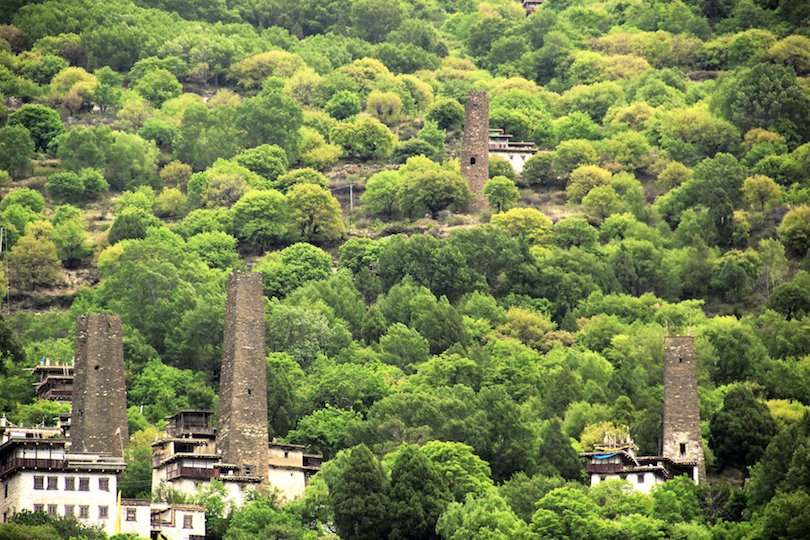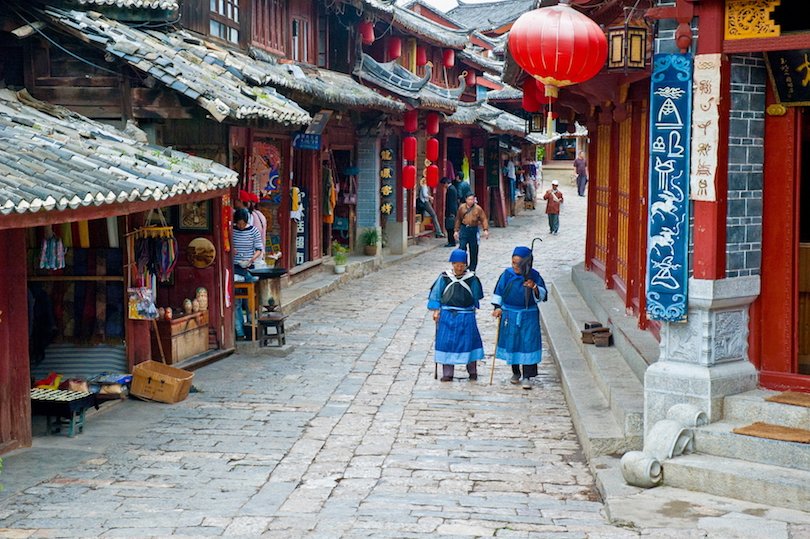14 Most Beautiful Small Towns in China. It is undergoing a rapid process of westernization, to the extent that even individuals who are well-versed in the ways of old China may struggle to identify it upon their return for a visit. The bustling cities of Beijing and Shanghai now resemble fast-paced metropolises like New York City or London. However, remnants of the old China, the one that aligns with our preconceived notions of the Middle Kingdom, still exist. To discover this side of China, one must venture into the rural areas where life moves at a slower pace in the villages and towns, and where ancient traditions continue to persist.
Suopo

Suopo can be likened to a delectable chocolate sundae, with its picturesque white stone buildings nestled amidst verdant forests and adorned with majestic brown towers. Originally inhabited by the Qiang people, this Tibetan village was once renowned for having the largest number of ancient watchtowers in existence. However, today, only 84 of these remarkable wooden and stone structures remain. Standing tall at heights ranging from 20 to 60 meters (66 to 196 feet), these thousand-year-old towers served various purposes, including serving as lookout points, storage facilities, and sacred spaces for worship.
Duoyishu

Duoyishu, situated in Yunnan Province in southwest China, is renowned for its rice terraces. These terraces are truly magnificent and can be regarded as masterpieces. The inhabitants of Duoyishu belong to the Hani and Yi minority communities. Witnessing the sunrise over the terraces is an experience that should not be overlooked. There are designated viewing platforms that enable you to capture the perfect photograph. In addition to their remarkable rice terraces, the Hani people are also recognized for their family-centric Chinese New Year festivities.
Heshun Town

Heshun Town, located in the western part of Yunnan Province, is renowned as one of the most enchanting villages in China. Its picturesque setting amidst lush hills and its name, which symbolizes tranquility and unity, contribute to its undeniable charm. The town is particularly celebrated for its impeccably preserved ancient architecture, where the stone houses adorned with tile roofs resemble captivating museums rather than mere residences. Meandering through the closely clustered homes are narrow lanes, adding to the town’s allure. Notably, Heshun Town served as a significant stop along the historic Tea-Horse Road.
Xijiang Qianhu Miao Village

The Miao people represent one of the 56 ethnic minorities in China. Renowned for their vibrant traditions, including singing, dancing, and exquisite embroidery, as well as their unique houses elevated on wooden stilts, they offer a captivating cultural experience. To immerse oneself in the Miao culture, Xijiang Town in Guizhou Province, located 35 km (22 miles) from Kaili, is the ideal destination. Within this town, Xijiang Qianhu stands as one of the ten villages, providing an authentic glimpse into the Miao way of life. Commence your exploration at the Miao Nationality Museum, where you will gain comprehensive knowledge about the Miao culture, satisfying any curiosities you may have had.
Hemu Village

Hemu Village, located in Xinjiang Province in west China, offers a captivating journey to the breathtaking Kanas Lake area. According to China National Geographic, Hemu is renowned as one of China’s most exquisite villages. Nestled in a charming garden-like setting, this small village is home to the Tuwa people who reside in traditional log cabins. The picturesque beauty of Hemu and its surroundings is so remarkable that numerous tour companies specifically arrange trips for photography enthusiasts. For capturing stunning shots, a viewing platform is conveniently situated on a nearby hill.
Chengyang Villages

Chengyang Villages offer a great opportunity to immerse yourself in the Dong culture. This group of eight villages is situated approximately five hours away from Guilin. Renowned for their rich folk culture, the villagers showcase their traditions through a captivating cultural performance held twice daily. Additionally, the villages boast a remarkable wooden wind-and-rain bridge, which is widely recognized as one of China’s most iconic structures, providing shelter from the elements. Surrounded by lush rice paddies and various crops, visiting during the autumn harvest season is highly recommended.
Hongcun

Hongcun, located near Mount Huangshan in Anhui Province, showcases a remarkable village design resembling an ox. The village’s layout is truly extraordinary, with a hill forming the head, two trees serving as the horns, four bridges symbolizing the legs, and the houses forming the body of the ox. Additionally, a stream gracefully flows through the village, representing the innards of this magnificent creature. Apart from its distinctive shape, Hongcun is renowned for its architectural marvels from the Ming and Qing dynasties. As one of the few remaining traditional Chinese villages, Hongcun stands as a testament to a disappearing way of life.
Zhouzhuang

Zhouzhuang, situated 30 km (18 miles) from Suzhou in eastern China, is an ideal destination to unwind amidst a busy trip. One can achieve this by embarking on a gondola ride along the canals of this water town. Apart from providing relaxation, this experience offers a unique perspective of the town. Zhouzhuang, with its 1,200-year-old history, boasts numerous remarkable attractions, including 14 arched stone bridges, with the Twin Bridges being the most renowned. Additionally, visitors can explore centuries-old residences constructed by affluent families and an 11th-century Taoist temple.
Fenghuang Ancient Town

Fenghuang Ancient Town in Hunan Province will leave you in awe, even if you have explored other old towns in China. This town, belonging to the Qing Dynasty and inhabited by the renowned Miao people known for their embroidery and silverwork, is truly a sight to behold. It offers a glimpse into China’s past, before the era of modernization. The town is adorned with a tranquil river, where wooden boats gracefully transport its residents. Its cobblestone streets, though narrow and well-worn, exude a certain charm. Additionally, some of the waterfront houses are built on stilts, adding to the town’s unique character. Fenghuang Ancient Town effortlessly combines simplicity and elegance, creating a captivating atmosphere.
Wuyuan Villages

The Wuyuan Villages encompass a series of rural villages renowned for their ancient architectural structures. Although numerous well-maintained buildings from the Ming and Qing dynasties can be found, there are also some that predate these eras, tracing back 1,300 years to the Tang Dynasty. These houses, constructed with white stone and adorned with gray tile roofs, possess a charming and picturesque allure. Undoubtedly, the entire Wuyuan region stands as one of China’s most breathtaking destinations. Spring proves to be an ideal season for exploration, as vibrant azaleas and rape flowers bloom while the tea plants flourish in lush greenery.
Tongli

When in Shanghai, it is essential to explore a water town. While many choose to visit Suzhou, the more knowledgeable travelers opt for Tongli. This tranquil town boasts an abundance of stunning gardens and temples that cannot be fully appreciated in just one day, so it is advisable to extend your stay. Embark on a leisurely cruise along the canals, where the water flows at a slower pace, aboard a traditional flat-bottom wooden boat. Perhaps you will catch a glimpse of elderly women washing clothes in the canal or witness a fisherman skillfully employing cormorants to catch fish.
Jiaju

If you are unable to spare time for a journey to Tibet, you can experience the essence of its culture by exploring Jiaju, a Tibetan-inspired village located in Sichuan Province. Known as the “Tibetan fairyland,” Jiaju is renowned as one of China’s most picturesque towns. Nestled on a lush hillside, it is difficult to dispute this claim, particularly during the spring season when pear trees bloom. The houses in Jiaju boast distinctive designs, featuring multi-tiered roofs adorned with crowns, while their eaves are painted in red and the exterior walls are adorned in white.
Lijiang Old Town

Lijiang Old Town, renowned as a prominent ancient town in China, exudes an enchanting allure reminiscent of bygone eras. The presence of waterways flowing through this village in Yunnan province further enhances its captivating ambiance. However, it is advisable to seize the opportunity to visit this remarkable destination before it succumbs to the consequences of rapid development. The excessive construction in the modernized area of Lijiang has resulted in a decline in the water table, consequently affecting the canals. Situated along the historic Tea-Horse trade route, Lijiang Old Town was once teeming with the vibrant Nakhi people. Regrettably, the escalating housing expenses have compelled them to relocate elsewhere.
Yangshuo Town is one of the 14 Most Beautiful Small Towns in China

Yangshuo Town, situated along the enchanting Li River, used to be a haven for backpackers. However, as more individuals uncover the allure of this region, it is gradually transforming into a more sophisticated destination. The karst mountains and caves that encircle the town possess an otherworldly charm, particularly during misty mornings when local fishermen can be seen navigating the tranquil waters in their quaint wooden boats. Exploring the countryside on a bicycle is a delightful activity that many visitors, like yourself, find enjoyable. A popular itinerary involves embarking on a boat journey to Guilin from Yangshuo on the Li River, followed by a scenic cycling expedition back to the town.





